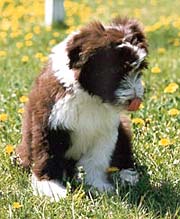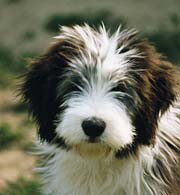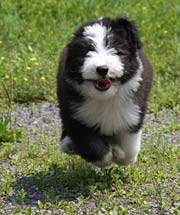|
Raising a puppy is an immense responsibility. That curious little bundle of fur needs to be taught all of the rules and proper behaviours required of a well-mannered dog in today’s society. Unfortunately, many dogs are not taught these things, and as a result grow up to be more than the owners can handle, ending with the dog being given up. The owner may claim the dog is stubborn, difficult, stupid, hyper, you name it, but invariably the dog is simply behaving the way he has been allowed to, or in fact encouraged to. A puppy is always watching, observing, testing, and learning. If you’re not aware of what you’re teaching, intentionally or unintentionally, the puppy could be learning all the wrong things!
Behaviours that we see in adults are the ones that were positively reinforced. An unwanted behaviour will be reinforced by repetition if steps aren’t taken to stop it. An example would be if a dog was allowed loose in the house while the owners were away, and proceeded to enjoy a good game of ‘chew the pillow to bits’. The owners come home, see the destruction, and are upset, annoyed, and angry, but the next day will often allow the dog loose in the house again when they leave, just hoping that it doesn’t happen again. The dog though has found a fun game so he does it again, and maybe now chews the chair and the carpet too. The dog won’t associate the owner coming home and yelling with his chewing, he’ll just think "Boy mom comes home in a bad mood these days!" So the destruction continues, and the owner is exasperated. But what did the owner do to teach the dog that this chewing was unacceptable or to prevent it from happening again? Nothing! So it should be no surprise that it continued.
A puppy is like a sponge, soaking in the world from his little vantage point. He looks to his owner for guidance, comfort, and direction, just like a human child. It’s no surprise that calm, quiet families often have calm quiet dogs, while loud, out of control families often have loud out of control dogs. A puppy learns what it lives.
For starters, remember that puppies are not bad, nor do they intentionally do bad things. They simply don’t know any better. Puppies are full of innocence and curiosity. It’s up to the owner to teach the pup what he is and isn’t allowed to do, and this is best achieved with consistency, calmness, and understanding. Yelling and hitting won’t teach the dog anything other than to be afraid and confused. Respect is earned by being fair, pleasant, and consistent, not forced by being heavy handed and mean.
Puppy proofing the house is the first step. The less trouble there is for a puppy to get into, the easier things will be. Move any favourite or breakable objects to where puppy can’t get at them, take the tablecloth off the table, or at least tuck the corners under so they aren’t dangling enticingly, put potted plants up on a counter, prized books on the higher levels of the bookshelf, Kleenex boxes on higher tables or a counter, and any easily toppled items such as plant stands or vases should be removed entirely. As the puppy grows and learns his manners these items can slowly be returned to where they were before his arrival. Look for any dangerous areas such as open stairs, or stair railings that a puppy could fall through, and block them off. It goes without saying that electrical cables, power bars, and plugs should be tucked out of the way, or access blocked off. A puppy should never be left unsupervised where he could have access to these dangerous items. If need be, unplug the cords, or use a product such as bitter apple to spray on them to deter him from chewing if he seems particularly interested in a specific cable.
Continued on the following pages:









